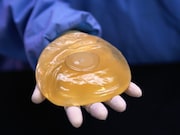Higher rates of Sjogren syndrome, scleroderma, RA, stillbirth, melanoma for silicone implants
FRIDAY, Sept. 21, 2018 (HealthDay News) — The long-term outcomes of breast implants include increased rates of certain conditions for silicone implants, according to a study published online Sept. 14 in the Annals of Surgery.
Christopher J. Coroneos, M.D., from the MD Anderson Cancer Center in Houston, and colleagues monitored long-term implant-related outcomes and systemic harms for silicone/saline implants from two manufacturers placed for primary/revision augmentation/reconstruction in U.S. Food and Drug Administration large post-approval studies (LPAS).
LPAS data were included for 99,993 patients. The researchers found that 56 percent of implants were silicone for primary augmentation. The rate of long-term magnetic resonance imaging surveillance was less than 5 percent. Silicone implants correlated with higher rates of Sjogren syndrome, scleroderma, rheumatoid arthritis, stillbirth, and melanoma (standardized incidence ratios, 8.14, 7.00, 5.96, 4.50, and 3.71, respectively), compared with normative data. There was one reported case of breast implant-associated anaplastic large cell lymphoma. No correlation with suicide was reported. Rupture was higher for saline (2.5 versus 0.5 percent) and capsular contracture was higher for silicone (5.0 versus 2.8 percent) in the short-term. The reoperation rate at seven years was 11.7 and 25 percent for primary augmentation and for primary/revision reconstruction, respectively. In 7.2 and 12.7 percent of primary augmentations and primary reconstructions, respectively, capsular contracture occurred.
“Silicone implants are associated with an increased risk of certain rare harms; associations need to be further analyzed with patient-level data to provide conclusive evidence,” the authors write.
Copyright © 2018 HealthDay. All rights reserved.








